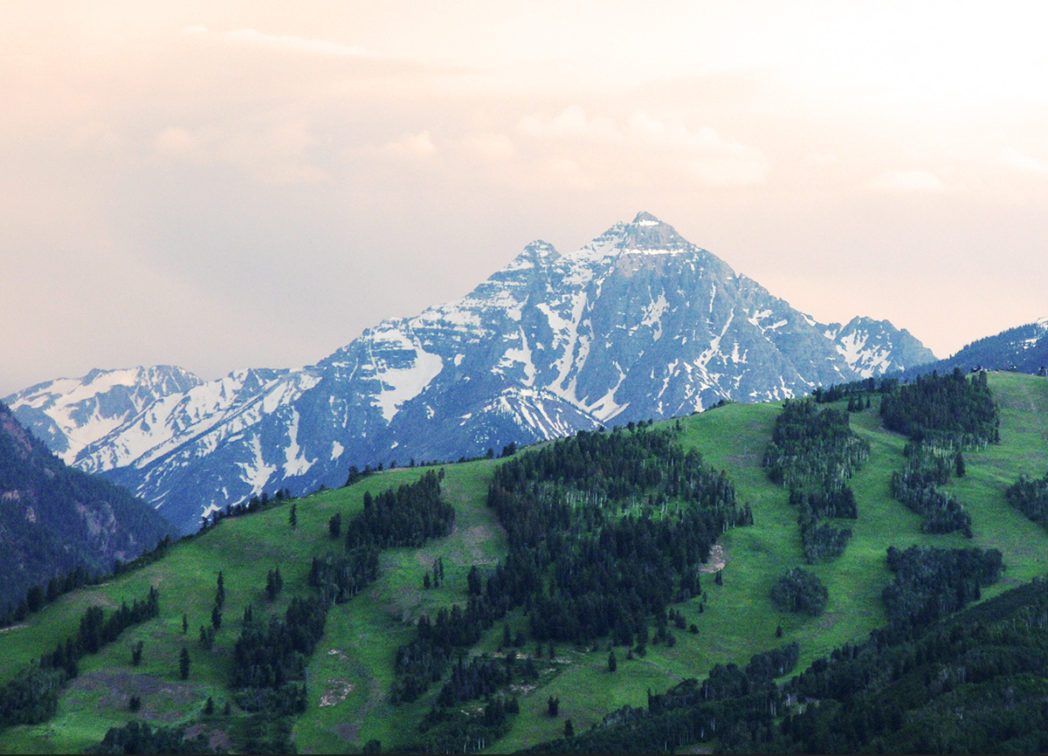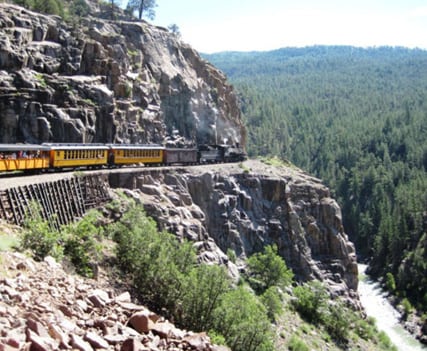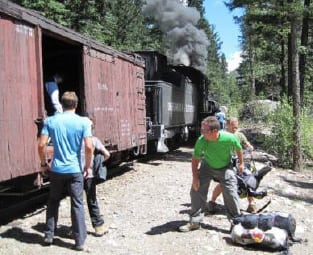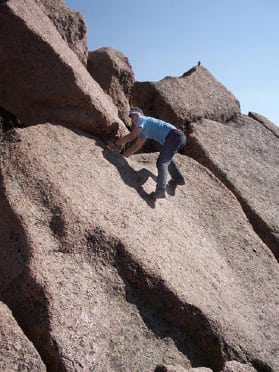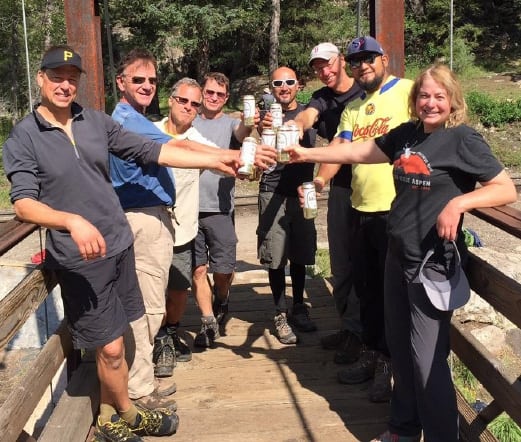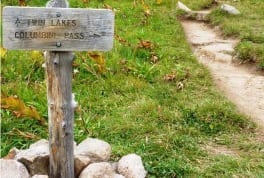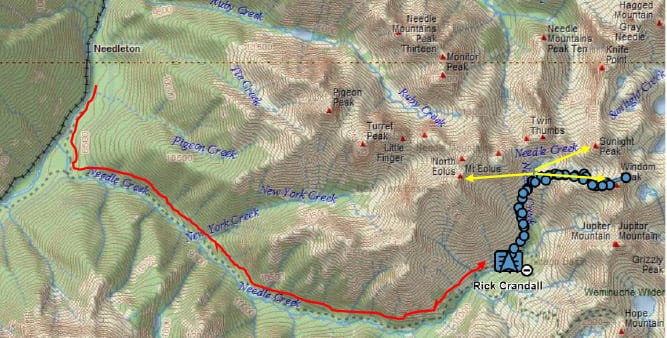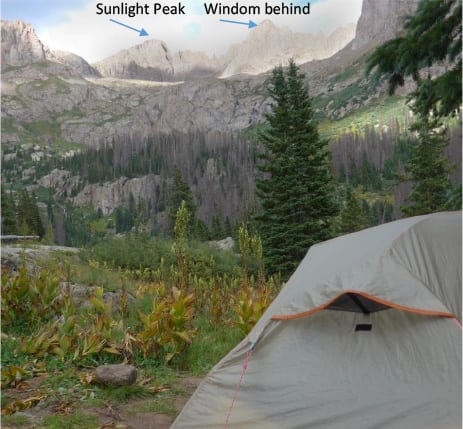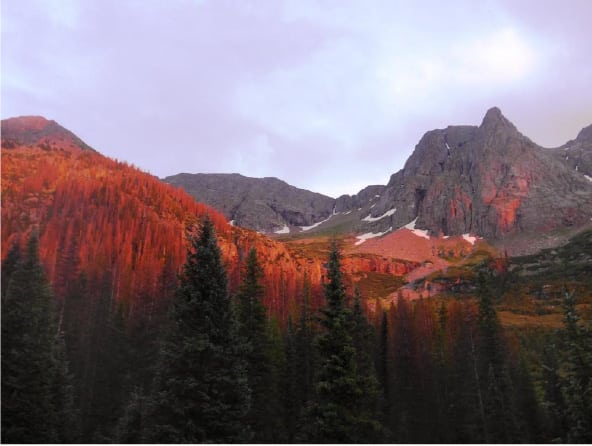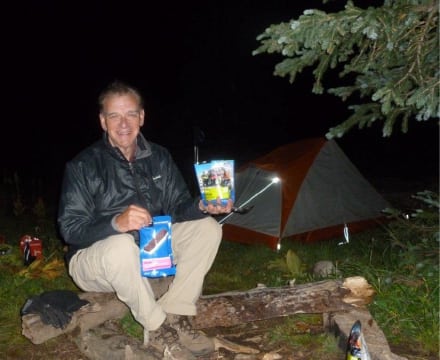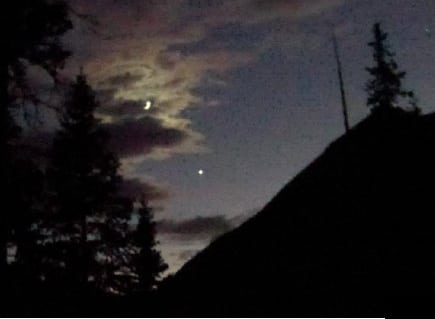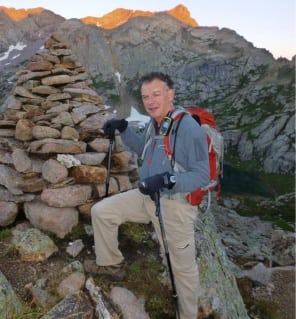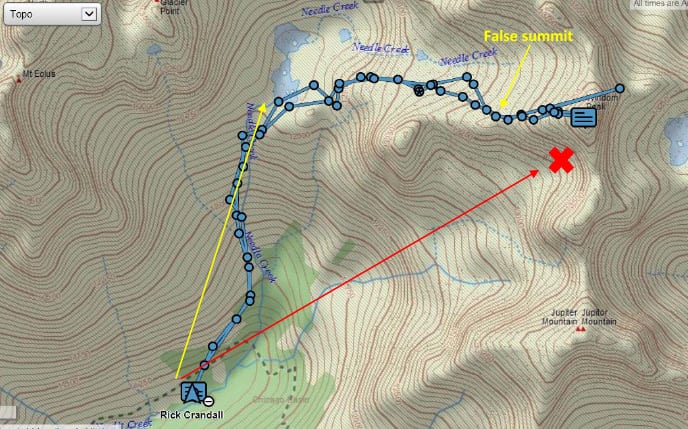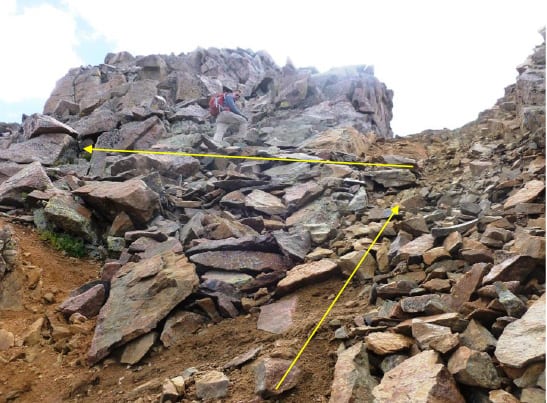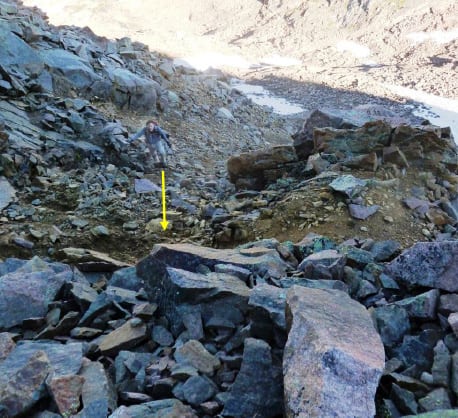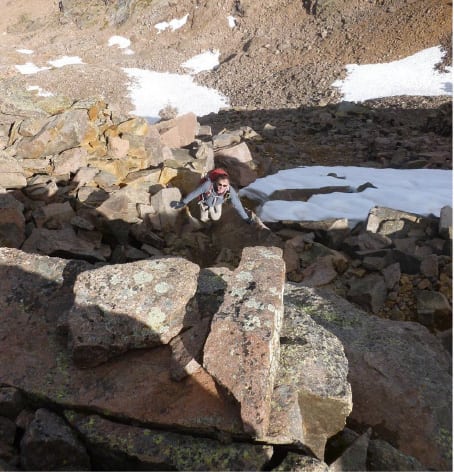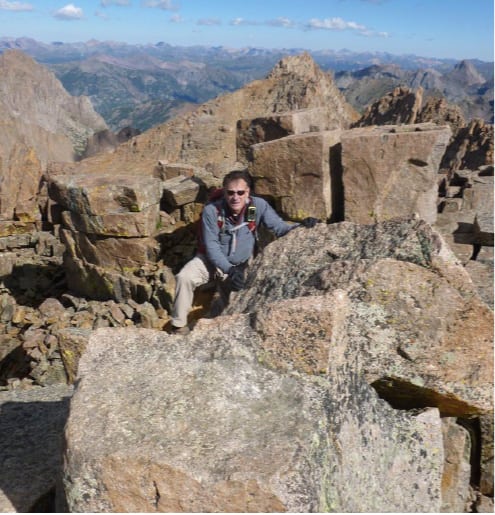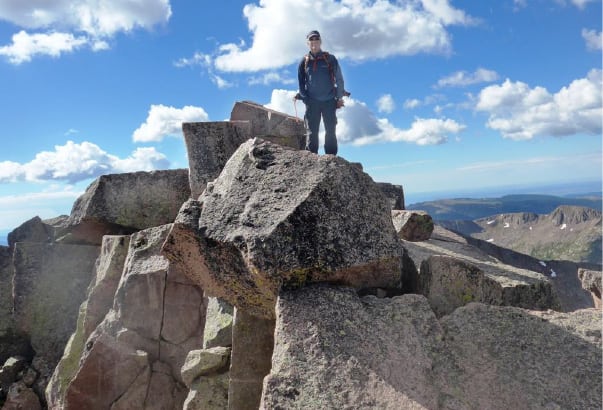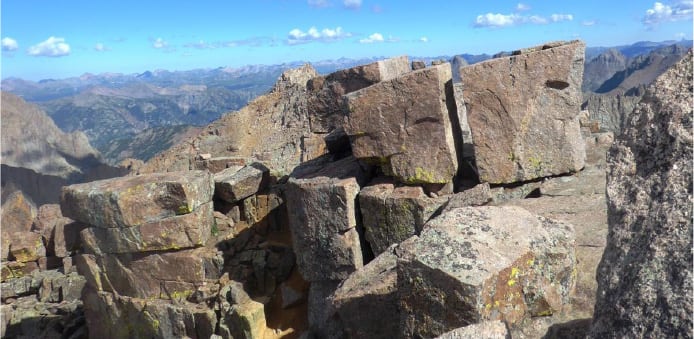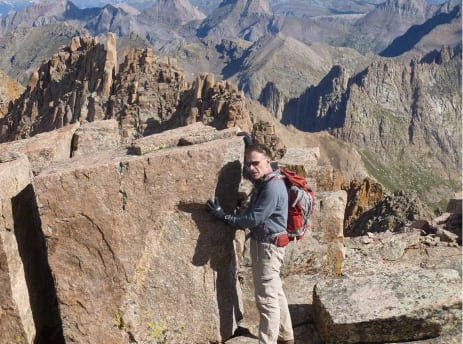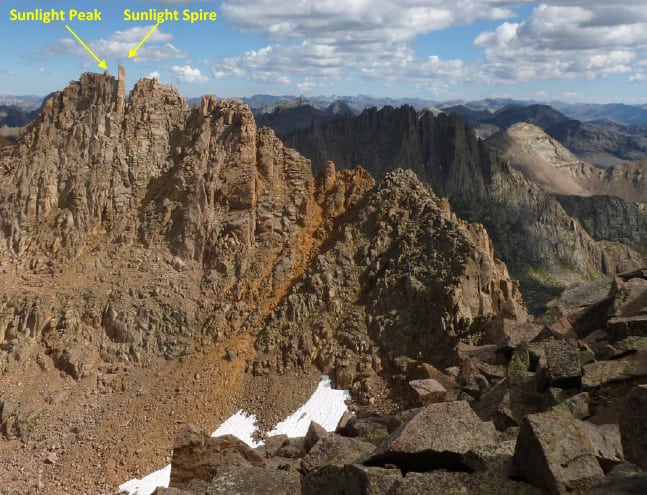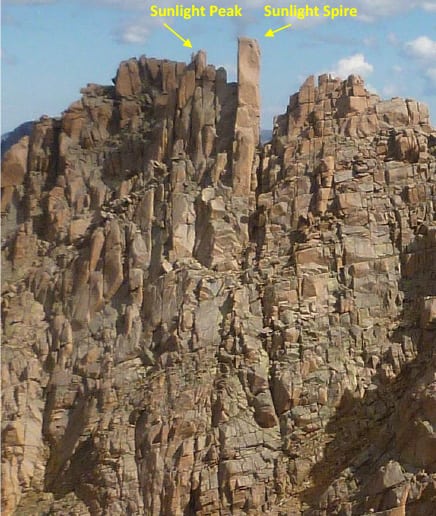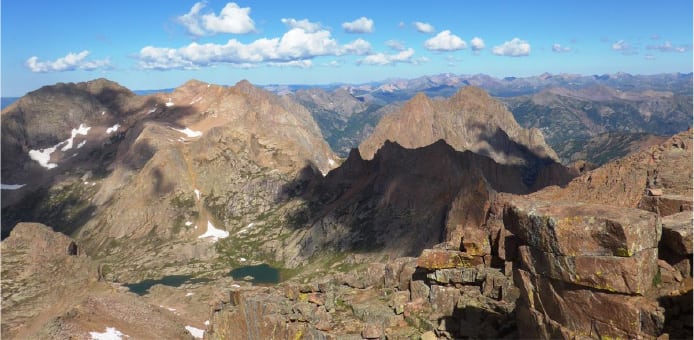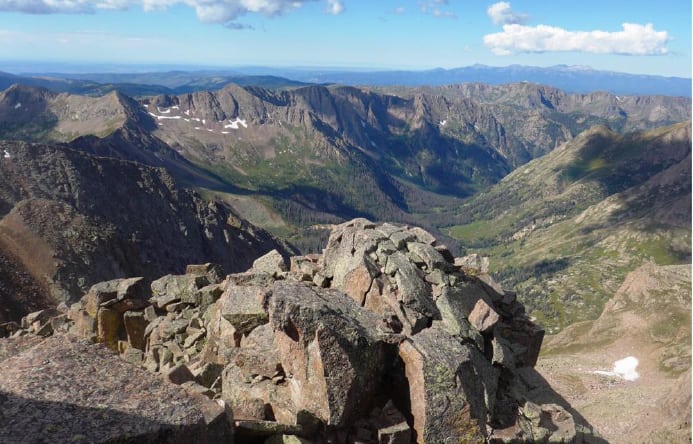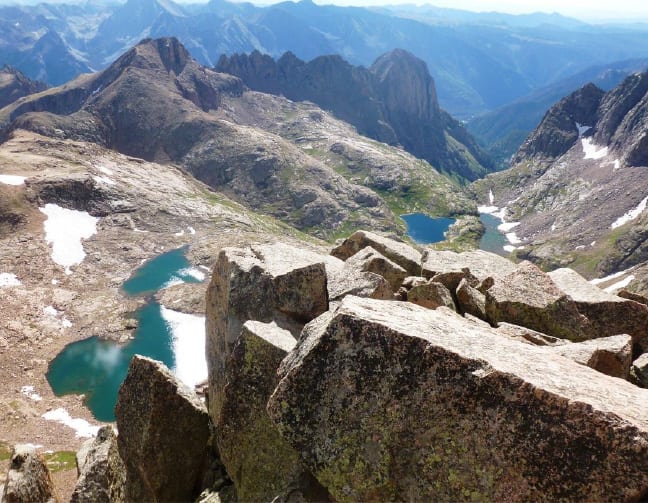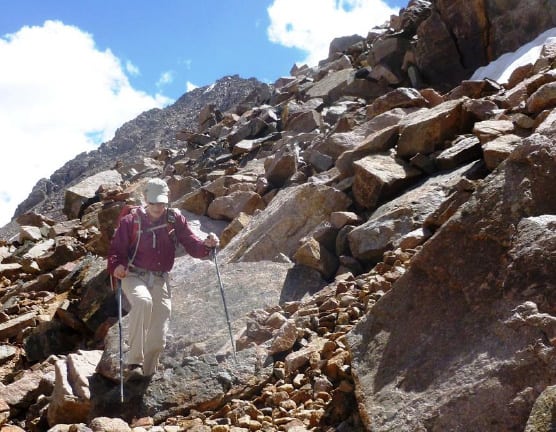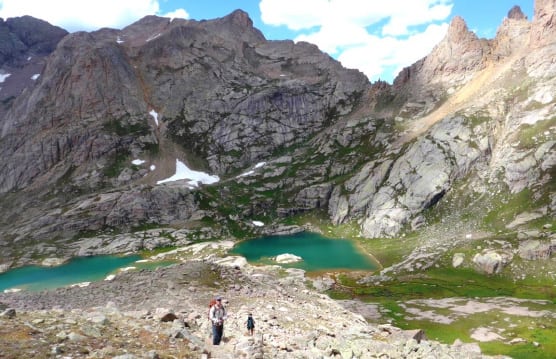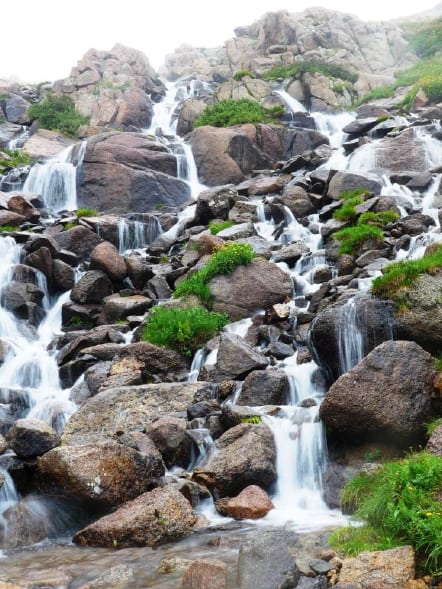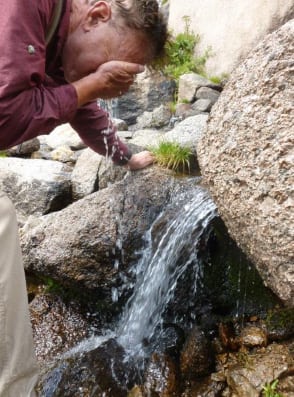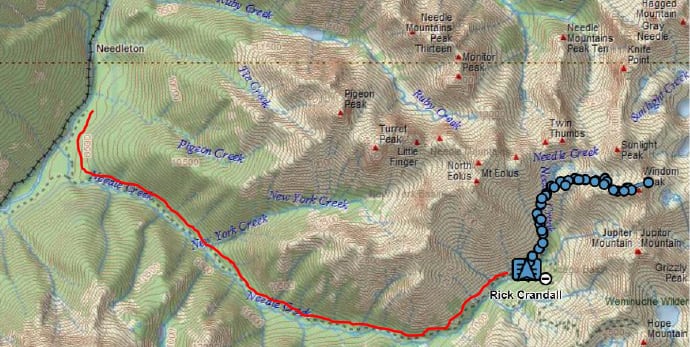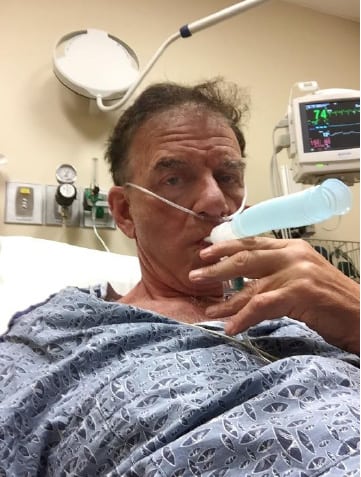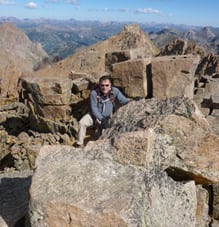
Difficulty: Class 3
Exposure: Significant exposure at summit
Summit Elevation: 14,082’
Elevation Gain: 6000’ from Needleton; 3000’ from Chicago Basin camp at 11,100’
Round Trip: 17 miles from Needleton; 5 miles from camp
Trailhead: Needleton stop on Durango & Silverton Narrow Gauge Train
Climbers: Rick Crandall; Rick Peckham | August 26, 2017
This will be quite a story with a few twists and turns including an important medical event at the end. I had to go four attempts at this mountain over the past 5 years, finally now summited I found, without question, Windom is the coolest summit of all 58 fourteeners. Windom Peak is in the Chicago Basin nestled deep in the San Juan Range. The other 14ers in that basin were summited earlier, the stories for Sunlight Peak and the Eoluses are at: www.rickcrandall.net/sunlight-peak-a-beauty-in-the-san-juans and www.rickcrandall.net/mt-eolus-and-n-eolus-exposed-rock-climbing ; both are favorite stories.
The Longest 14er Approach
The story starts by traveling either to Durango or Silverton and boarding the 110 year-old narrow-gauge train with original steam locomotive. It travels high on the cliff along the Animas River. The train ride alone can give some people altitude fear. For those hiking to Chicago Basin you buy a special back-packer ticket and you get dropped off in the middle at a ghost town called Needleton.
When you return, to get the train to stop and pick you up you MUST stand on the East side of the tracks and repeatedly cross your hands in front of you, like doing the Charleston. If you don’t, they won’t stop.
Your packs are unloaded from the 100 year-old box car and the train takes off, not to return until the next day.
How cool a start of a climb is that?
Four Attempts
My first attempt at Windom was in 2012 when a group of us got into the Basin going for Sunlight Peak, another unique 14er with a Class 4 summit block. We succeeded on it and tried to go straight for nearby Windom, but altitude sickness caught up with some of us and we stopped about 500’ short of its summit.
On that Sunlight climb, we had my son Brett who led, my brother Wayne who summited this hard mountain as a first-timer, and friend Rick Peckham who is in many of these stories.
Brett Crandall here is making the Class 4 moves to the summit blocks of Sunlight Peak. Now that’s exposure!
Then in 2014, Rick Peckham and I went back to Chicago Basin twice to finally get Eolus and North Eolus, but got weathered out (threatening storms) also trying for Windom on one of the trips.
Then earlier this summer, August 5th, we got a big group of 8 together, and we went back in. Others summited but I didn’t like the weather prospects given my lack of speed, and once again I was foiled.
Here at the Needleton Bridge is that recent group, left to right:
Andy Mishmash, me, Rick Peckham, Mike Ives, Willy Vargas, Clif Slade, Marcos Molina and Andy’s wife Susan Muenchen.
Readers of these stories will know Andy as a top class 5+ technical climber and friend who has helped me up the most difficult 14ers. Clif and Mike have accompanied up a few with me but are also going for them all. Willy and Marcos came along for the trip and had a lifetime experience! Susan is a Class-5 climber who can follow Andy’s lead up almost anything.
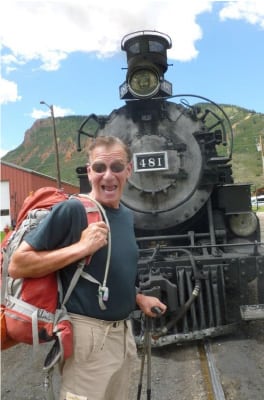 So on August 25th, 2017 here I was again for the fifth time trekking all the way into that Basin. In this photo: Am I excited about going back into that Basin or just scared the train is going to test my persistence further by threatening to run me over?
So on August 25th, 2017 here I was again for the fifth time trekking all the way into that Basin. In this photo: Am I excited about going back into that Basin or just scared the train is going to test my persistence further by threatening to run me over?
Actually Rick Peckham deserves credit for being with me on all those times – I might apply for him to become Mayor of Chicago Basin and its large goat population. Recall that Rick P. is a friend from Alaska who has visited at our home for a month each summer – he is retired military para-jumper search and rescue pro and a paramedic. He’s also a climber of some skill.
Once dropped off at Needleton, it is a 6 mile backpack with full packs for two overnights, up 3000’ to the Chicago Basin. For me a good timing is 4 hours.
NOTE to Climbers: About 5 miles in toward the Basin you’ll start seeing tents. I like to go ¾ mile further for better campsite views and to shorten the climb the next day. Our site is on the right just before the trail junction sign on the left, where, in the dark the next morning, you’ll go left up 1500’ to Twin Lakes.
The red-arrow path on the map starts at the Needleton train drop-off and follows the Needle Creek six miles into the basin. From there the climbs all entail hiking first up to Twin Lakes and then the yellow arrows show the basic direction to each of the 14ers. The blue dots are our actual route to Windom summit from camp.
Views in the Basin are great all in themselves.
Our camp looked right up at Sunlight and Windom (actually more like the false summit, Windom is hiding behind).
This shot is striking because of end-of-the-day sun, but the sadness is that the red trees are alpenglow on dead pines, victims of the pine-beetle destruction.
Beauty in death.
Here’s me at camp, we had to move quickly to get there – the train let us off at 3:40pm and since it’s late August, we lose the daylight at 8:15pm so backpacking 4 hours would get us to our favorite camp position with a ½ hour to set up tents, string up our food (keep from the bears at night), fill up with filtered water from the creek, pour the wine and heat water for our dehydrated food. We like the Mountain House spaghetti and meat balls, but we ran out so I had the Lasagna which was ok. I’m holding a new idea – dehydrated ice-cream bars for dessert – yum!
Those of you who read my Little Bear climb (the most dangerous 14er) know that 2 years ago I’d gotten a gift to consult with a Chinese astrologer. Among many things he said the planet Venus would look over me for 14 years (!!) and make things good. Now that’s my kind of prediction, and sure enough, as with Little Bear, this night there was the moon and VENUS. I took that to mean this time, the 4th attempt, was going to be a success.
The Climb
The next morning we were up at 3am and I was not feeling right. I had all the symptoms of food poisoning – headache, dizziness, nausea and the other thing. Well I dealt with the latter in the privacy of the dark and the trees, and started following Rick P. very slowly uphill. I used my hiking sticks for balance and just plodded. Fortunately the path to Twin Lakes has been improved by the Colorado 14ers Initiative and the trail was good. Somehow I made it to the Lakes at 12,500’ in 2 hours and the symptoms started subsiding. We forged on above the Lakes in darkness but huge cairns marked the way (unlike later on). Note the alpenglow on the distant higher peaks at sunrise by about 7am.
Those who were watching my real-time track from my satellite GPS were concerned we’d lost our way – they saw the yellow-line progress which seemed to be going away from Windom. They might have expected something like the red-line direction, but that would lead to almost sheer cliffs.
Access to all the 14ers there involves first hiking to Twin Lakes. Next as you see from the track, we circumvented the Lakes on the right and headed up on a good path. We then crossed in a gradual upswing until we approached the false summit.
This is where it gets really rocky and deserving of the Class 2 designation (at this point, the rating goes up later). You nearly summit this but don’t have to go right to the top, rather circumvent the summit on the left.
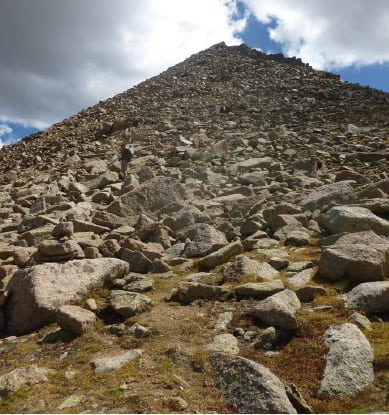
This is the base of the false summit.
Then you swing around to the left until you see a gully leading up to a narrow saddle that has nothing on the other side. There’s no cairns here, or in places there are too many cairns in too many directions. We climbed up the gully and turned left just before the saddle.
Final Climb to Summit
Finally swinging further around to the right, here I am heading towards the final 800’ climb to the summit – this is where it definitely gets into Class 3 rock climbing or “scrambling” as some call it.
Up I go. The boulders get bigger and oddly enough, more and more cubic-shaped. They are great for climbing – super handholds and obvious foot placements all the way up. Still – particularly the descent would not be for the amateur unless fit and is accompanied by someone who can give pointers.
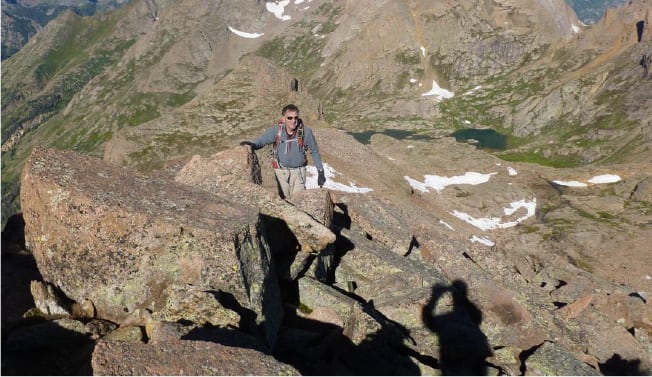
These rocks look loose and maybe they are but they’re so big and heavy and have so many unusual flat surfaces, they fit together well and are stable.
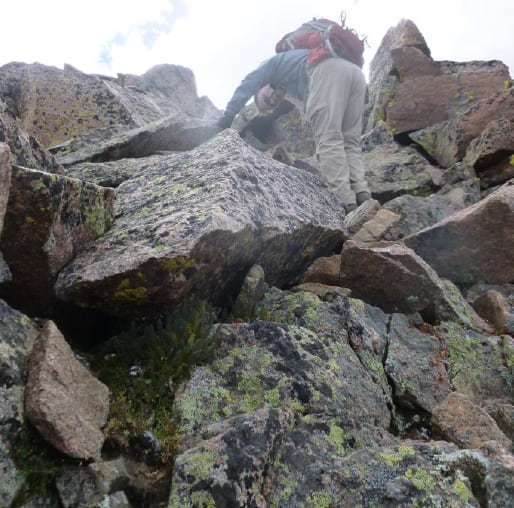
Here’s me trucking up at about 9:45am.
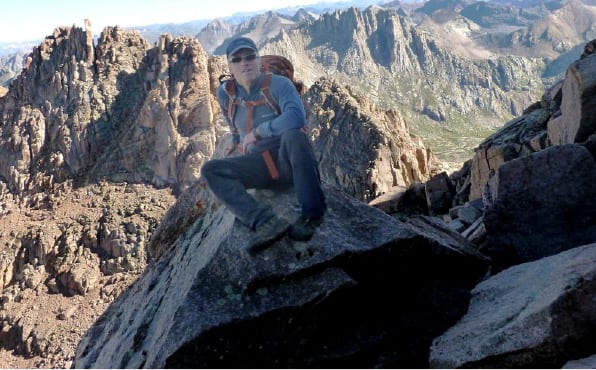
And here’s Rick P. – always ahead of me and always confirming the route.
Route-finding is a VERY big piece of conquering this mountain.
Here I am approaching the very unusual summit of blocks that look like they were somehow put there by a mysterious force, like were the Incas there? No. The Martians? Maybe.
Wait ‘till you see more pictures below.
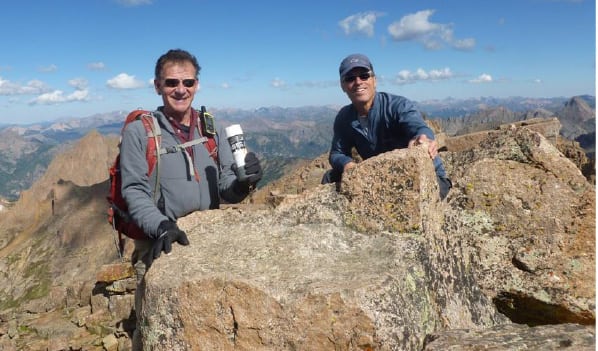
Ahh. How sweet it is. I’m holding the summit signature canister that is on all the 14er summits.
Summit Windom Peak 14,082’ at 10:00 am, Saturday, August 26, 2017, 6 ½ hours from camp.
Now just look at these summit blocks. Can you get an idea from these pictures how unreal this is? How did they get there? There is nowhere higher than a 14er in the entire continental United States so they didn’t fall from anywhere on earth. I’m sure a geologist has a theory (email me).
They’re like a bunch of kids’ blocks …
… except they are HUGE!
And that’s not the only thing special about this summit. The views of the San Juans are breathtaking on a clear day – which thankfully we had.
Here from Windom’s summit we’re looking over at Sunlight, another 14er we did before. That too is quite a mountain.
Sunlight Spire bears mentioning. It looks taller than Sunlight Peak (14,066’) but it’s not. Before the rechecking of all mountain heights in Colorado which were found to be 7’ higher than before known, Sunlight Spire was 13,993’. Now it is a 14er at exactly 14,000’. Fortunately it doesn’t qualify as a 14er because the low point from it to Sunlight isn’t much of a dip. I say fortunately because just look at it. The Sprire is a Class 5-10 highly-technical climb with just a jamcrack to get the last 40’ to it’s summit and it is overhung 4%. Andy Mishmash is the only guy I know personally who’s done it.
Now for the rest of the amazing views from the Windom summit.
Descent
10:30 am and time to go all that way back down – just to get to camp. I was feeling exhilarated, we’d finally broken the jinx of this mountain, but I never celebrate until down from all the hard stuff. No other mountain took 4 tries and this one is harder to get to than all the rest, including many train rides that aren’t free! But there’s a twist to this story coming up at camp.
Here’s Rick P. down past the hard stuff at Twin Lakes – everywhere you turn it is beauty unfolded. At this point I got emotional – we high-fived and hugged – this was persistence and success all in one.
Now I’m no professional photographer, but what came out of my camera on this climb was just amazing. Here’s the mother of all waterfalls, right?
I’d worked really hard on this climb – 11 hours from camp to summit back to camp – and that’s after a 4 hour forced march up 3000’ and 6 miles from the train the afternoon before. I couldn’t resist a freshener.
Not Done Yet – A Problem Arose
OK well here’s the twist to this story. There’s going to be a medical description here, but it’s relevant to climber safety. We got back to camp at around 3pm. Rick P. immediately took a nap. As I relaxed I realized I wasn’t breathing right, I was taking in deeper breaths to get enough oxygen. Of course I’d just exerted hard for 11 hours and was still now at camp at 11,000’ for one more night. But normally my recovery time when I get out of breath on the way up is about 60 seconds. Here I was stationary and not recovering.
Years ago when I started climbing, I had trouble breathing well at above about 13,000’. I went to National Jewish Hospital (top specialty in pulmonary in the country) and the doc chuckled, he said “lets see you live at 8500’ and no problem hiking, biking, and skiing. So you climb to 13,000’ and you have some trouble breathing, well so do a lot of people, although you do have some long-term lung function impairment.” He said, “but I get it, you love climbing, so try taking an inhaler with you (basically Albuterol) and take 2 deep inhales every 2 – 3 hours up high.” I did that and it helped – so I’ve had an inhaler with me on every climb. What a saver that turned out to be!
In my current situation, I took a few puffs and I could breathe again – for about 1 ½ hours and then had to puff again. I was up all night in my tent worried what was wrong and wondering how was I going to backpack all the way down 6 miles to the train, then an hour on the train and a 4-hour car ride from Silverton to Aspen.
You get the picture, I was trapped.
I got through the night with the inhaler – we got up at 4am and Rick P. was Mr. Efficient helping to get the site packed up. He also took even more of my pack weight – my tent and food. We got up early because I thought it was going to be slow going back and the train was at 11:15am with no other pickup options that day.
Recall how far we needed to go (red line) to get to the train tracks and a chance at civilization.
In fact we made it back to the track by 9:30am and we were on the train at 11:25am. By 1pm we were in our car and driving back to Aspen. Upon arrival in Aspen and a recommendation of my good doctor friend Dennis Cirillo, I checked my oxygen saturation as soon as I got home – it was a bad 82 so I went straight to the Aspen Valley Hospital Emergency Room. They were great.
They kicked into action with oxygen, an Albuterol feed and a chest x-ray. It wasn’t long until they determined I had a “Reactive Airway” condition – I’d overtaxed my lungs, the alveoli within were drying out on the strenuous climb and attracting rescue moisture which was blocking their effectiveness in extracting oxygen.
The solution? As the doc put it, they were going to “crack” the condition. That meant deep inhalations of the albuterol and forced, complete emptying exhales – which is really hard in that condition. But after two 15 minute shots at that they’d “cracked” most of it and I was already back up to higher oxy saturation on natural air. Further improvement is expected with more lung clearing from some days rest and a course of prednisone steroid which acts as an anti-irritant.
Ugh – well I’m always showing reality in these stories – this time it’s me. Puffing on the albuterol and wondering when I could get to the next climb. The doc said I should be ready to go just after Labor Day and I’m going to hold him to it!
The Lesson
I tell this whole story for a reason. Skilled climbers and young, fit people probably don’t have to worry about this. But occasional hikers, moderately-fit people or older people who do a climb might use high exertion to get a summit and this could happen. Even great climbers at higher altitudes risk this condition and its successor, pulmonary edema. My recommendation is to get an Albuterol inhaler and have it as part of a small first-aid kit. For you or someone you’re with – it could be a life saver. I’m adding it to the equipment list I keep on my web site at: www.rickcrandall.net/wp-content/uploads/pdf/Equip List for blog.pdf
So one more great climb done, and as seems always to be the case – it got to be quite a story. What I’ll remember is as always – the research, the preparation, the challenge, the beauty, the friendship, and of course, the execution to summit. In this case, having proper equipment came through.
